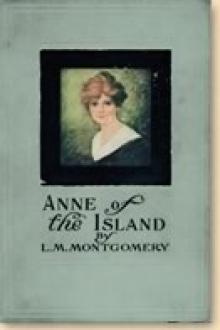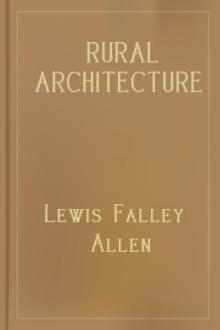A History of Art for Beginners and Students, Clara Erskine Clement Waters [best beach reads .txt] 📗

- Author: Clara Erskine Clement Waters
- Performer: -
Book online «A History of Art for Beginners and Students, Clara Erskine Clement Waters [best beach reads .txt] 📗». Author Clara Erskine Clement Waters
About a year after Holbein went to Basle he was called to Lucerne to decorate a house, and he executed other works there and at Altorf. In 1519, when he had been three years in Basle, he became a citizen of that town and a member of its guild of painters. His works at Basle were mostly decorative, and he painted few easel pictures there.
Holbein married a widow with one son; her name was Elizabeth Schmid. She had a very bad temper. It is said that she made Holbein’s life so miserable that he left Basle for that reason. He visited her sometimes, and always gave her money, but lived away from her. In 1526 Holbein went to England, and his friend Erasmus said that he went because he had so little to do in Basle. He carried a letter to Sir Thomas More, who received him with great kindness, and the artist made many portraits of Sir Thomas and his family. There is a story about one of these portraits of that nobleman. He had refused to be present at the marriage of Anne Boleyn to King Henry VIII., and she never forgave him. On the day that More was executed she looked at one of Holbein’s portraits of the ex-chancellor and exclaimed, “Ah, me! the man seems to be still alive;” and seizing the picture she threw it into the street.
In 1530 Holbein returned to Basle to complete some unfinished frescoes, and this being done he went again to London. About this time he began to be employed by the king, and did many pictures for him from time to time. In 1538 Henry sent Holbein to Brussels to make a portrait of the Duchess of Milan, of whom the king was thinking for his fourth wife. No citizen of Basle was allowed to enter the service of a foreign sovereign without the consent of the council, so in 1538 the artist went home to ask permission to serve the King of England. Great efforts were made to keep him in Basle, but at last he received permission to remain two years in England: the artist never went again to Basle. Henry VIII. became fond of Holbein, and was generous to him, even giving him a painting-room in the palace of Whitehall.
In 1539 the artist was sent to paint a portrait of Anne of Cleves, whom the king married the next year. It has been said that the picture was so flattering that when the king saw the lady he was disappointed; we know that he was soon divorced from her.
In 1543 the plague raged in London, and on the 7th of October Holbein prepared his will. He died before the 29th of November, but the facts concerning his death and burial are not known.
There are several interesting anecdotes of Holbein. One relates that when passing through Strasburg he visited the studio of an artist, and finding him out, painted a fly on a picture which was on an easel. When the painter saw the fly he tried to brush it away, and when he found who had painted it he searched the city for Holbein; but he had already left for England. Another story shows the regard which Henry VIII. had for him. One day a nobleman went to Holbein’s studio, and insisted upon entering, though the artist told him that he was painting the portrait of a lady by his Majesty’s orders. The nobleman persisting, Holbein threw him down the stairs with great violence, and then rushed to the king, and told him what he had done. Soon after the nobleman was borne to the presence of the king; he was unable to walk, and was loud in his complaints. The king ridiculed him, and the nobleman was angry, and threatened to punish the artist legally. Then Henry got angry, and said: “Now you have no longer to deal with Holbein, but with me, your king. Do you think that this man is of so little consideration with us? I tell you, my lord, that out of seven peasants I can make seven earls in a day; but out of seven earls I could not make one such artist as Hans Holbein.”
Dresden Gallery.
At Basle one may see some of the most important of the early portraits of Holbein; these are in the gallery where are also his ten well-known scenes from the Passion of Christ. While at Basle he probably made the designs for the “Dance of Death.” For a long time it was believed that he painted this subject both at Basle and at Bonn, but we now know that he only made designs for it. He also decorated the Town Hall at Basle; of this work, however, but little remains.
The most celebrated work by Holbein is the “Meyer Madonna” in the royal palace of Darmstadt, of which there is a copy in the Dresden Gallery. It takes its name from that of the Burgomaster Meyer, for whom it was painted. The Madonna, with the infant Jesus in her arms, stands in a niche in the centre of the picture; the burgomaster and his family kneel before her. This is what is called a votive picture, which means a picture made in the fulfilment of a vow, in gratitude for some signal blessing or to turn away some danger. Many of these works commemorate an escape from accident or a recovery from sickness.
The picture is very beautiful, and it seems as if the Virgin wished to share her peace with the kneeling family, so sweet is the expression of her face, while the child seems to bestow a blessing with his lifted hand. The original was probably painted for a “Chapel of Our Lady.”
His “Dance of Death” was very curious, the idea being that Death is always near us and trying to strike down his prey. The pictures represent a skeleton clutching at his victims, who are of all ages and occupations, from the lovely young bride at the altar to the hard-working pedlar in the cut we give here, and all of them are hurried away by this frightful figure which stands for Death itself.
Holbein made many wood engravings, but none so important as these. When the set is complete there are fifty-three cuts, but it is rare to find more than forty-six.
Holbein was one of the foremost of German masters. All his pictures are realistic, and many of them are fantastic; he gave graceful movement and beauty of form to many of his subjects; his drapery was well arranged; his color and manner of painting were good. He painted in fresco and oil colors, executed miniatures and engravings. His portraits were his best works, and in them he equalled the greatest masters. The most reliable portrait of this artist is in the Basle Museum. It is done in red and black chalk, and represents him as a man with regular, well-shaped features, with a cheerful expression which also shows decision of character.
There were other good artists in the Augsburg school after the time of the Holbeins; but I shall pass immediately to the Franconian school, or that of Nuremburg, and to its great master, Albert Dürer (1471-1528), whose life was very interesting, and who stands, as an artist, among the greatest painters of the world. The city of Nuremburg was a grand, rich old place even in Dürer’s time, and as a boy he was familiar with its scenery and architecture, which helped him to cultivate his artist tastes, and to make him the great man that he became. He was an author of books as well as an architect, sculptor, painter, and engraver.
His father was a goldsmith, and Albert was apprenticed to the same trade; but he was so anxious to study painting that at length his father placed him as apprentice to the painter Michael Wohlgemuth. At this time Albert was fifteen years old, and the two years he had spent with the goldsmith had doubtless been of great advantage to him; for in that time he had been trained in the modelling of small, delicate objects, and in the accurate design necessary in making the small articles in precious metals which are the principal work of that trade.
Albert Dürer had a very strong nature, and Michael Wohlgemuth was not a man who could gain much influence over such a youth. During the three years which Dürer passed under his teaching he learned all the modes of preparing and using colors, and acquired much skill in handling the brush; he also learned the first lessons in wood-engraving, in which he afterward reached so high a perfection that a large part of his present fame rests upon his skill in that art.
One of the earliest portraits painted by Dürer is in the Albertina at Vienna, and bears this inscription: “This I have drawn from myself from the looking-glass, in the year 1484, when I was still a child. Albert Dürer.” Six years later he painted the beautiful portrait of his father which is now in the gallery at Florence; and it is a question whether this is not as finely executed as any portrait of his later years.
When Dürer left Wohlgemuth he started upon the student journey which was then the custom with all German youths, and is still practised in a modified degree. These youths, after serving their apprenticeship in the occupation they were to follow, travelled, and worked at their trade or profession in the cities of other countries. Dürer was absent four years, but we know little of what he did or saw, for in his own account of his life he says only this: “And when the three years were out my father sent me away. I remained abroad four years, when he recalled me; and, as I had left just after Easter in 1490, I returned home in 1494, just after Whitsuntide.”
In the same year, in July, Dürer was married to Agnes Frey. He was also admitted to the guild of painters, and we may say that he was now settled for life. It is a singular fact that, although Dürer painted several portraits of his father and himself, he is not known to have made any of his wife. Some of his sketches are called by her name, but there is no good reason for this.
Dürer was so industrious, and executed so many pictures, copper-plates, and wood engravings within the six years next after his return to Nuremburg, that it is not possible to give an exact account of them here. In 1500 an event occurred which added much to his happiness and to his opportunities for enlarging his influence. It was the return to Nuremburg of Willibald Pirkheimer, one of the friends of Dürer’s childhood, between whom and himself there had always existed a strong affection. Pirkheimer was rich and influential, and at his house Dürer saw many eminent men, artists, scholars, reformers, and theologians, and in their society he gained much broader knowledge of the world, while he received the respect which was due to his genius and character.
Virgin Mary.
Dürer’s health was not good, and his continual work proved more than he could bear. His father died in 1502, and this loss was a deep grief to the artist. So little money was left for his mother and younger brother that their support came upon him. At length, in 1505, he made a journey to Venice, partly for his health, and in order to study Venetian painting.





Comments (0)